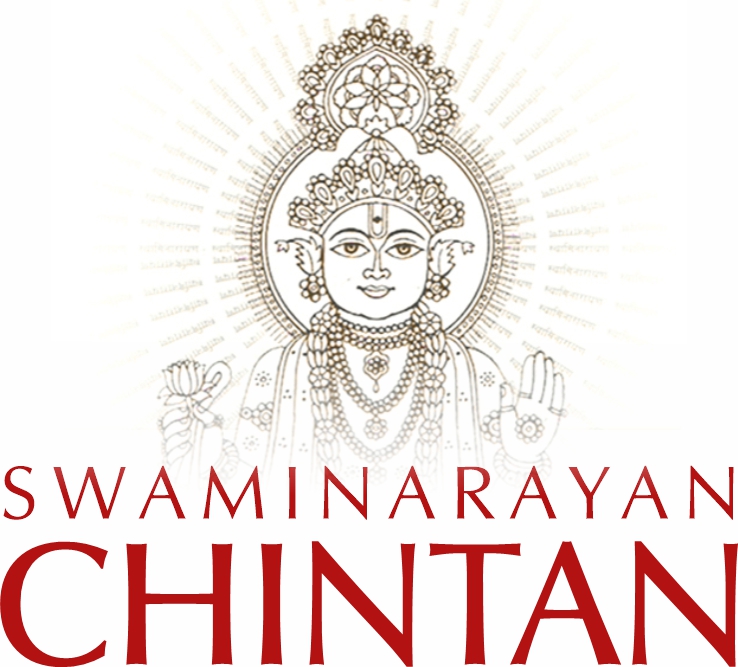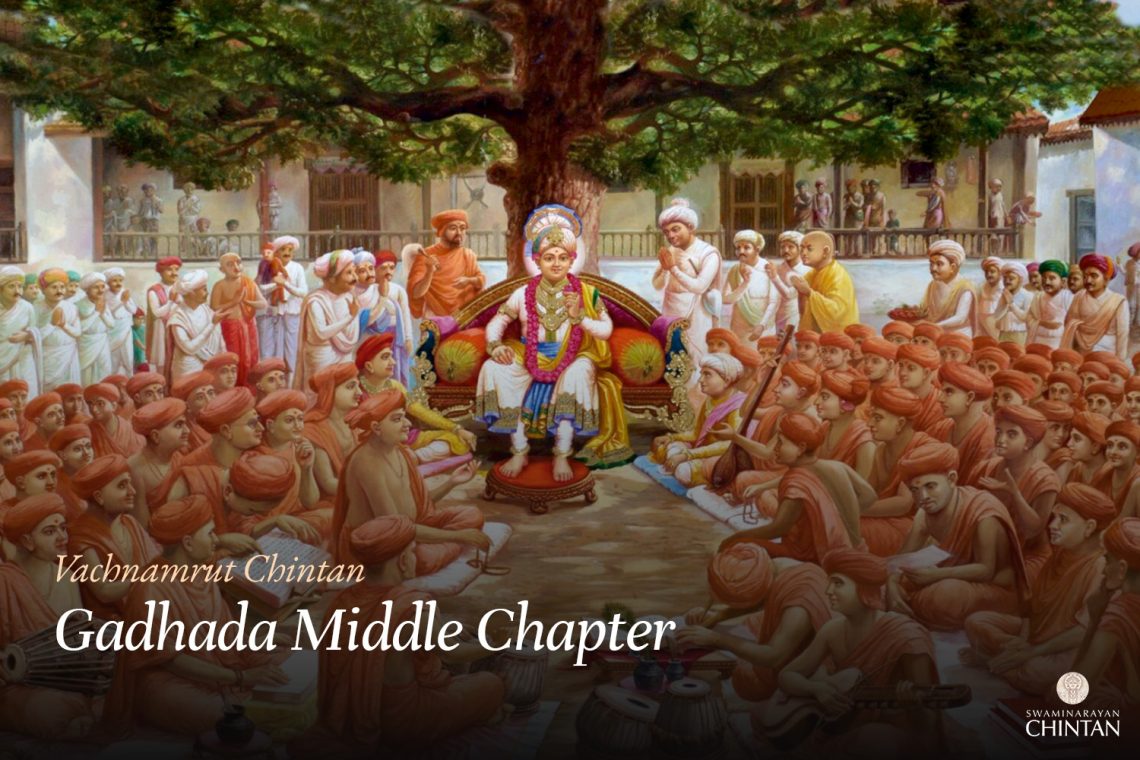Central Insights:
- Characteristics of one who truly understands the supremacy of satsang.
Key Points:
- Only one who has developed atma-buddhi—a sense of deep identification—with the Sant of Bhagwan can truly perceive satsang to be greater than all spiritual disciplines.
Explanation:
In this Vachanamrut, Shreeji Maharaj references a verse from the twelfth chapter of the Eleventh Canto of the Bhagavat Purana, where Shri Krishna tells Uddhav, “Through astanga-yoga, sankhya, austerity, renunciation, pilgrimages, vows, sacrifices, or charitable acts—I am not won over to the extent that I am through satsang.” From this, it is evident that satsang surpasses all other forms of spiritual practice.
Maharaj then poses a question to the assembly: What are the characteristics of one who sees satsang as superior to all other disciplines? Though the sants respond according to their understanding, none provide a completely satisfactory answer.
Subsequently, Shreeji Maharaj explains: Such a person is one who has developed atma-buddhi toward the Sant of Bhagwan. For instance, consider an elderly king who, after a long time, is blessed with a son. Even if that son insults him or pulls his mustache in jest, the king feels no resentment—because he sees his son as an extension of his own self. Similarly, even if someone were to accuse or assault that child, the king remains unwavering in affection. Why? Because he has developed atma-buddhi—a deep-seated identification—with his son.
In the same way, one who has developed atma-buddhi toward the Bhakta of Bhagwan alone perceives satsang to be the most exalted and redemptive path. This is further affirmed by a verse from the Bhagavatam:
यस्यात्मबुद्धिः कुणपे त्रिधातुके स्वधीः कलत्रादिषु भौम इज्यधीः |
यत्तीर्थबुद्धिः सलिले न कर्हिचित् जनेष्वभिज्ञेषु स एव गोखरः ||
yasyātma-buddhiḥ kuṇape tridhātuke
svadhīḥ kalatrādiṣu bhauma ijya-dhīḥ |
yat tīrtha-buddhiḥ salile na karhicit
janeṣv abhijñeṣu sa eva gokharaḥ ||
(Śrīmad Bhāgavatam 10.84.83)
He who considers the body to be the self, and sees wife, family, birthplace, and holy waters as mere material affiliations, but does not possess atma-buddhi in enlightened beings—is no better than a cow or an ass.
Here, Maharaj clarifies that satsang is not merely about physical association. The word sang here connotes asakti—emotional attachment. Thus, satsang means attachment to sat—that which is eternal and true. While sang can denote physical proximity, Maharaj
emphasizes its deeper meaning—emotional identification and bonding.
The analogy of the king and his son highlights that when such asakti and atma-buddhi arise toward the Sant of Bhagwan, that is true satsang. This is the essence of Maharaj’s teaching.
Two well-known scriptural accounts further illuminate this truth:
1. Narad and the Insect:
Once, when Narad visited Vaikuntha, he requested Bhagwan to reveal the true glory of satsang. Instead of giving a direct answer, Bhagwan sent him to the forest to meet a certain insect. As soon as Narad addressed the insect, it died. This sequence repeated with a parrot, a calf, and a prince—all of whom died upon hearing the question. Confused and distressed, Narad returned to Bhagwan, who explained: “I did not kill them; rather, by mere contact with a Sant like you, these souls attained liberation and progressed through successive births, finally attaining Vaikuntha.” This exemplifies how even the briefest contact (lava-satsang) with a true Sant elevates the soul
2. Vishvamitra and Vasistha:
When Vasistha visited Vishvamitra’s ashram, Vishvamitra offered him the fruit of 60,000 years of austerity as a mark of respect. Later, when Vishvamitra visited Vasistha, he was offered the fruit of a mere moment (lava) of satsang. Offended, he sought arbitration from Sheshji, who asked Vishvamitra to place the fruits of both his penance and the lava-satsang on either side of his hood. The Earth lifted only when the lava-satsang was placed—establishing its superior spiritual potency over even tens of thousands of years of austerity.
Even if no discourse occurs, and no ideas are exchanged,
when asakti arises toward a Sant of Bhagwan—even for a fraction of a moment—that is lava-satsang. The benefits of this are immeasurable, as Shreeji Maharaj emphasizes through the earlier shloka. If atma-buddhi and sanctity are falsely projected onto the inert body, spouse, rituals, or sacred rivers, while failing to revere the enlightened Sant—then such a person is likened to an ass.
A Profound Insight:
Maharaj subtly introduces another key concept—that satsang consists of four elements: attachment to (1) sat—the Supreme, (2) one’s true self, (3) sat—the scriptures, and (4) sat—the realized Sant. However, in this Vachanamrut, Maharaj chooses to emphasize only the Sant, without explicit mention of the other three. Why?
Even though Bhagwan is the source and primary object of devotion, and thus should ideally be the focus of one’s asakti, Maharaj declares that attachment to the Sant is itself satsang. The reason is that genuine attachment to a true Sant naturally includes attachment to Bhagwan and the other three facets. If a Sant does not connect one to Bhagwan, he is not a true Sant.
Gunatitanand Swami encapsulated this idea succinctly: “He who unites one with Bhagwan is a Sant; he who binds one to himself is not.” Similarly, Brahmanand Swami affirmed: “The true Sant awakens love for the feet of Bhagwan.”
Hence, when Maharaj defines sang as asakti, and directs it toward the Sant of Bhagwan, He reveals the true essence of satsang and demonstrates why it is superior to all other spiritual endeavors.
Glossary
| Satsang – Association with truth sant Emotional and spiritual attachment to Bhagwan, His Sant, scriptures, and one’s true self |
| Atma-buddhi – Deep identification of the self Seeing someone (like a Sant) as one’s very own self or extension of one’s self, affection like one’s own family member. |
| Sant – Enlightened saint A spiritually realized soul who connects others to Bhagwan |
| Asakti – Emotional attachment Deep affectionate bond or attachment—especially towards the Sant or Bhagwan |
| Lava-satsang – Even a momentary contact with a Sant The immense spiritual benefit one receives from even a fraction of a moment in the company of a true Sant |
| Vaikuntha – Eternal abode of Vishnu |
| Mumukshu – Seeker of liberation A person striving to attain moksh or ultimate liberation |
| Kalyan – Spiritual redemption Ultimate welfare of the soul; synonymous with moksh |
| Sheshji – Divine serpent incarnation The multi-headed serpent who supports the universe, often invoked for arbitration in scriptures |
| Tapasya – Austerity Spiritual penance undertaken with great resolve |

